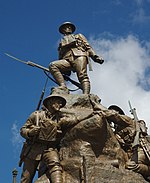Oldham Central railway station
Disused railway stations in the Metropolitan Borough of OldhamFormer Lancashire and Yorkshire Railway stationsGreater Manchester railway station stubsRailway stations in Great Britain closed in 1966Railway stations in Great Britain opened in 1847 ... and 1 more
Use British English from December 2016
Oldham Central railway station was opened on 1 November 1847 as part of the extension of the Middleton Junction to Oldham Werneth line to Oldham Mumps. It was eventually one of six stations in the town of Oldham and was adjacent to Clegg Street railway station which closed on 2 May 1959. Although Central was conveniently located close to the town centre it was selected for closure, shutting on 18 April 1966 and virtually no trace of it now remains. A factor in its closure may have been its relative closeness to the Werneth and Mumps stations.The name of the station survives in the Oldham Central tram stop, which is located on Union Street.
Excerpt from the Wikipedia article Oldham Central railway station (License: CC BY-SA 3.0, Authors).Oldham Central railway station
Wellington Street,
Geographical coordinates (GPS) Address External links Nearby Places Show on map
Geographical coordinates (GPS)
| Latitude | Longitude |
|---|---|
| N 53.5379 ° | E -2.1104 ° |
Address
Oldham Central
Wellington Street
OL4 1SR , Primrose Bank
England, United Kingdom
Open on Google Maps







